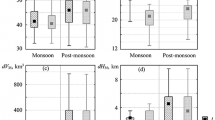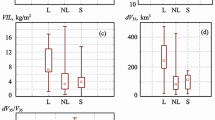Abstract
The analysis of field observations of thunderclouds in India is provided. The characteristics of the cloud collection obtained from the radar and lightning detection network in the area of the city of Aurangabad (the Maharashtra province, India) are considered. The maximum radar reflectivity of thunderstorm cells, the volume of the supercooled part above the 0°C isotherm, the intensity and precipitation flux, and the frequency of electric discharges are obtained. It is shown that the frequency of electric discharges is linked with some radar parameters of thunderclouds, and this relationship depends on the stage of cloud development. Comparative field data for other regions are given.



Similar content being viewed by others
REFERENCES
Yu. P. Mikhailovskii, A. A. Sin’kevich, S. D. Pawar, V. Gopalakrishnan, Yu. A. Dovgalyuk, N. E. Veremei, E. V. Bogdanov, A. B. Kurov, A. Kh. Adzhiev, A. M. Malkarova, and A. M. Abshaev, “Investigations of the Development of Thunderstorm with Hail. Part 2. Analysis of Methods for the Forecast and Diagnosis of the Electrical Properties of Clouds,” Meteorol. Gidrol., No. 6 (2017) [Russ. Meteorol. Hydrol., No. 6, 42 (2017)].
A. A. Sin’kevich, Yu. A. Dovgalyuk, N. E. Veremei, and Yu. P. Mikhailovskii, Merging of Convective Clouds, Ed. by E. L. Makhotkina (St. Petersburg, 2018) [in Russian].
A. A. Sin’kevich and T. V. Krauss, “Efficiency of Convective Cloud Seeding with Crystallizing Reagents for Precipitation Augmentation,” in Radar Meteorology and Weather Modification, Ed. by E. L. Makhotkina (St. Petersburg, 2012) [in Russian].
A. A. Sin’kevich, Yu. P. Mikhailovskii, Yu. A. Dovgalyuk, N. E. Veremei, E. V. Bogdanov, A. Kh. Adzhiev, A. M. Malkarova, and A. M. Abshaev, “Investigations of the Development of Thunderstorm with Hail. Part 1. Cloud Development and Formation of Electric Discharges,” Meteorol. Gidrol., No. 9 (2016) [Russ. Meteorol. Hydrol., No. 9, 41 (2016)].
D. E. Buechler and S. J. Goodman, “Echo Size and Asymmetry: Impact on NEXRAD Storm Identification,” J. Appl. Meteorol., 29 (1990).
D. Siingh, P. S. Buchunde, R. P. Singh, A. Nath, S. Kumar, and R. N. Ghodpage, “Lightning and Convective Rain Study in Different Parts of India,” Atmos. Res., 137 (2014).
C. Farnell, T. Rigo, and N. Pineda, “Exploring Radar and Lightning Variables Associated with the Lightning Jump. Can We Predict the Size of the Hail?”, Atmos. Res., 202 (2018).
M. S. Gremillion and R. E. Orville, “Thunderstorm Characteristics of Cloud-to-ground Lightning at the Kennedy Space Center, Florida: A Study of Lightning Initiation Signatures as Indicated by the WSR-88D,” Wea. Forecast., 14 (1999).
D. M. Lal and S. D. Pawar, “Relationship between Rainfall and Lightning over Central Indian Region in Monsoon and Premonsoon Seasons,” Atmos. Res., No. 4, 92 (2009).
X. Li, Y. Pan, and Z. Mo, “Joint Effects of Several Factors on Cloud-to-ground Lightning and Rainfall in Nanning (China),” Atmos. Res., 212 (2018).
C. Liu, D. J. Cecil, E. J. Zipser, K. Kronfeld, and R. Robertson, “Relationships between Lightning Flash Rates and Radar Reflectivity Vertical Structures in Thunderstorms over the Tropics and Subtropics,” J. Geophys. Res., No. D06, 117 (2012).
D. R. MacGorman and W. D. Rust, The Electrical Nature of Storms (Oxford University Press, New York, 1999).
W. A. Petersen, H. J. Christian, and S. A. Rutledge, “TRMM Observations of the Global Relationship between Ice Water Content and Lightning,” Geophys. Res. Lett., No. 14, 32 (2005).
V. A. Rakov, “The Physics of Lightning,” Surv. Geophys., 34 (2013).
U. Saha, A. Maitra, S. K. Midya, and G. K. Das, “Association of Thunderstorm Frequency with Rainfall Occurrences over an Indian Urban Metropolis,” Atmos. Res., 138 (2014).
F. Wang, X. Qie, D. Wang, and A. Srivastava, “Lightning Activity in Tropical Cyclones and Its Relationship to Dynamic and Thermodynamic Parameters over the Northwest Pacific,” Atmos. Res., 213 (2018).
F. Wu, X. Cui, and D. Zhang, “A Lightning-based Nowcast-warning Approach for Short-duration Rainfall Events: Development and Testing over Beijing during the Warm Seasons of 2006–2007,” Atmos. Res., 205 (2018).
Author information
Authors and Affiliations
Corresponding author
Additional information
Translated from Meteorologiya i Gidrologiya, 2021, No. 6, pp. 99-106. https://doi.org/10.52002/0130-2906-2021-6-99-106.
About this article
Cite this article
Sin’kevich, A.A., Toropova, M.L., Mikhailovskii, Y.P. et al. Features of the Relationship between Electrical and Radar Parameters of Thunderclouds in India (Field Studies). Russ. Meteorol. Hydrol. 46, 410–415 (2021). https://doi.org/10.3103/S106837392106008X
Received:
Published:
Issue Date:
DOI: https://doi.org/10.3103/S106837392106008X




